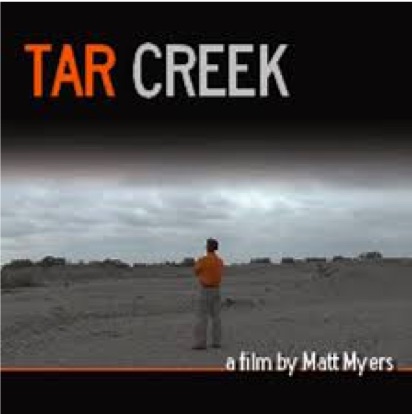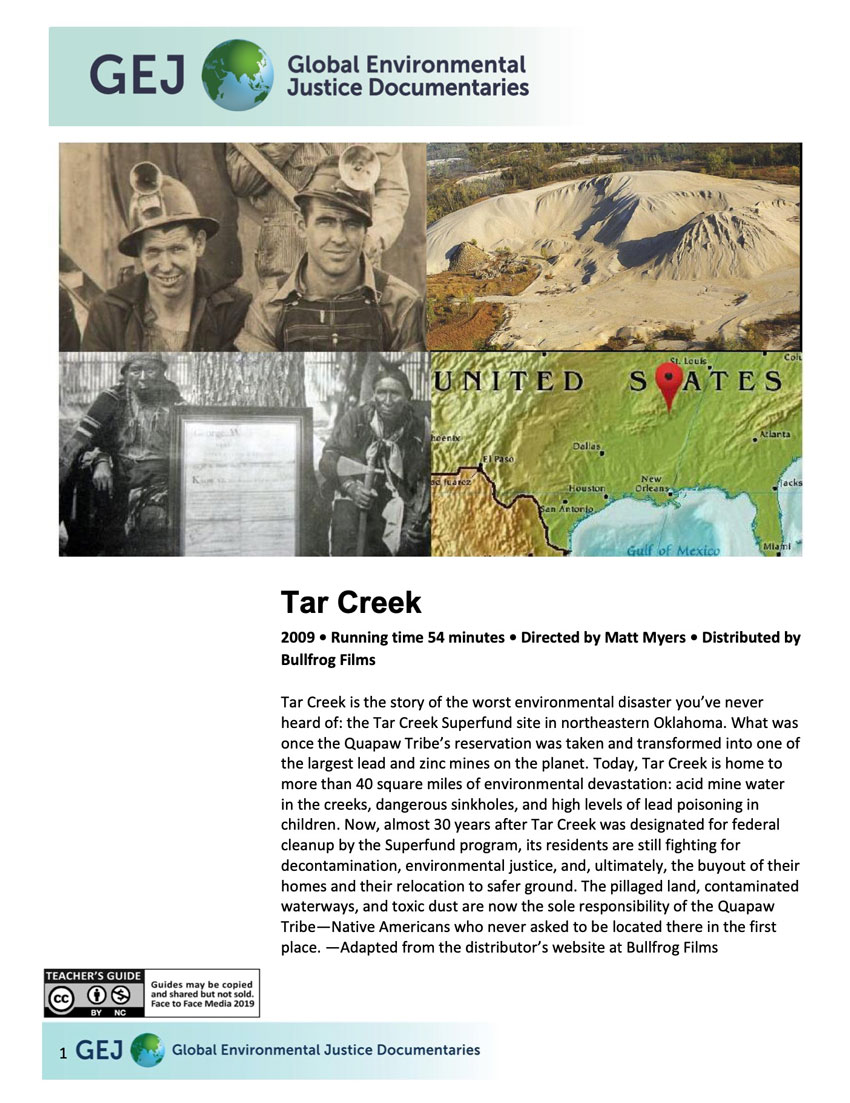Curator
 — Amity Doolittle, Senior Lecturer and Research Scientist, Yale School of Forestry and Environmental Studies
— Amity Doolittle, Senior Lecturer and Research Scientist, Yale School of Forestry and Environmental Studies
Tar Creek
The story of the worst environmental disaster you've never heard of in northeastern Oklahoma. What was once the Quapaw Tribe’s reservation was taken and transformed into one of the largest lead and zinc mines on the planet. Today, Tar Creek is home to 40 square miles of environmental devastation, and its residents are fighting for environmental justice.

Curator and writers
This documentary was selected by Amity Doolittle, senior lecturer and research scientist at the Yale School of Forestry and Environmental Studies.
The guide was written by Caleb Northrop and Caroline Scanlan, with research support from Elham Shabahat and Liz Felker, graduate students at the Yale School of Forestry and Environmental Studies.
Why this film was chosen
The long sweep of historical injustices against the Quapaw Tribe makes this film extremely compelling. After being evicted from their homelands in the early 1800s, the Quapaw were relocated to Tar Creek, Oklahoma, on land that appeared useless to the U.S. government. However, once lead was discovered there in the early 1900s, the Secretary of the Interior attempted to once again deprive the Quapaw of their land rights by declaring individuals who owned land with large lead deposits “incompetent” so the government could manage the access to the lead below ground.
After all the valuable minerals had been extracted, the Quapaw were left with land that had no economic value. And most recently, even after the negative health impacts of lead on children’s development were understood, the Environmental Protection Agency (EPA) and the U.S. government have failed to adequately remediate the land, compensate the landowners, or relocate the families who have been exposed to the lead contamination.
Teacher's guide
Please see the teacher's guide for maps, background information and suggested subjects, questions and activities.
Synopsis
Tar Creek is the story of the worst environmental disaster you’ve never heard of: the Tar Creek Superfund site in northeastern Oklahoma. What was once the Quapaw Tribe’s reservation was taken and transformed into one of the largest lead and zinc mines on the planet. Today, Tar Creek is home to more than 40 square miles of environmental devastation: acid mine water in the creeks, dangerous sinkholes, and high levels of lead poisoning in children. Now, almost 30 years after Tar Creek was designated for federal cleanup by the Superfund program, its residents are still fighting for decontamination, environmental justice, and, ultimately, the buyout of their homes and their relocation to safer ground. The pillaged land, contaminated waterways, and toxic dust are now the sole responsibility of the Quapaw Tribe—Native Americans who never asked to be located there in the first place. —Adapted from the distributor’s website at Bullfrog Films
The environmental justice focus of the film
This film highlights how environmental contamination can affect people, particularly indigenous communities, who are fighting for clean, healthy, and safe environments for their families and children. While non-Native American residents fled their homes after the attempts to clean up the Tar Creek site failed, members of the Quapaw Tribe who were forcibly relocated to the area in the first place remain, and they continue to be exposed to dangerous pollution from the lead and zinc mines. The film draws attention to the long history of marginalization and willful neglect that Native Americans have experienced at the hands of the U.S. government and corporate extractive industries—abuses that continue today.
“Tar Creek is amazingly clear and moving, full of many human voices and important issues of environmental justice and the interconnected nature of ecology and human lives…It highlights the history and ongoing drama of how so many people have been impacted by one of worst EPA Superfund sites in the United States” – John Calderazzo, Professor of English, Colorado State University
Awards
2011 Environmental Film Festival in the Nation’s Capital 2011 Oneota Film Festival 2011 Frozen River Film Festival 2011 Cinema Verde Environmental Film & Arts Festival
Citation
Main credits
Myers, Matt (film producer)
Myers, Matt (narrator)
Myers, Matt (film director)
Beer, Tanya (film producer)
Other credits
Director of photography, Robert Billings; original music by Watermelon Slim; edited by Matt Myers.
Distributor credits
Tanya Beer
Matt Myers
Director – Matt Myers
Producer – Tanya Beer
Executive Producers – Ron and Cara Beer
Director of Photography – Robert Billings
Docuseek subjects
North American Studies
Water
Toxic Chemicals
Illness, Disease and Disorders
Rivers and Lakes
Sustainability
Americas, The
Energy
Toxic Waste
Government Policy
Communication and Media Studies
Mining Sector
Citizenship, Social Movements and Activism
Human Rights
Global / International Studies
Habitat Destruction
Pollution
Geography
History
Ethics
Ecology
United States
Environmental Geography
Gender Studies
Distributor subjects
Capitalism
Democracy
Environmental Justice
Environmental Law
Government
Health and Health Care
Human Rights
Indigenous Studies
Mining
Native American Studies
North American Studies
Pollution Rivers
Toxic Chemicals
United States
Water
Keywords
Welcome to Docuseek2!
Docuseek2 is a streaming platform of the best documentary and social issue films available for the higher education community.
Anyone may search for titles and find detailed information about the titles. To preview films or license them for streaming, you must register and login.
Currently, we support online registration for anyone affiliated with a higher education institution. Please inquire if you are with a K-12 district or school or with a public library.
Click the Close button to get started!


